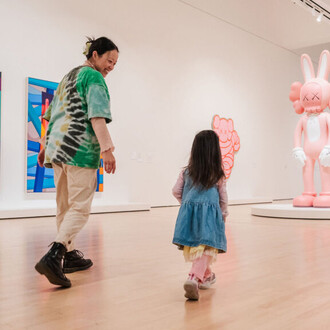Selections coincides with Catherine Wagner’s solo exhibition, Archaeology in Reverse, opening September 8th at the Mills College Art Museum. Archaeology in Reverse is an immersive full-scale installation using the space and architectural framework of the museum. Wagner’s photographs often serve as interventions within a chosen space and context, addressing the cultural meanings embedded in accepted social practice and institutions. At MCAM, she works with the architectural firm modem (Nicholas de Monchaux and Kathryn Moll) to reconfigure the space in light and color, isolating elements (some normally unseen) and animating them with site-specific choreography by Molissa Fenley, documented on video by Michael Mersereau. A catalog with an essay by Rudolf Frieling (Curator of Media Arts, SFMOMA) accompanies the exhibition.
Complementing both Selections and Archaeology in Reverse is the artist’s new monograph, Catherine Wagner: Place, History and the Archive, a just-published survey of her work with an interview by fellow photographer Stephen Shore and essay by Shoair Mavlian (Former Assistant Curator of Photography, Tate Modern). Featuring over 200 reproductions of the artist’s photographs dating from the mid-seventies to the present, the new Damiani publication provides an insightful overview of Wagner’s explorative way of working in series, examining institutions and social conventions as constructions — from art museums to science labs, classrooms, the home, and even Disneyland. Copies of Catherine Wagner: Place, History and the Archive are available at the gallery.
Selections will present specific works from Catherine Wagner’s many investigative bodies of work. The following series will be represented: her series from the 70’s, Early California Landscapes, is comprised of black and white photographs that focus on California construction sites urbanizing the legendary landscape, rather than on the beautiful wilderness consecrated by photographers of the historical “West”, her forebears.
In 1978 she was commissioned to record the transformation of San Francisco’s city center in The Moscone Site, in its day the biggest urban construction project in the West. Photographing the development of the colossal building site with the hyper-real clarity of a large format camera began her interest in future ruins, or archaeology in reverse.
Wagner was also commissioned by the Canadian Center for Architecture to develop The Architecture of Reassurance, working with the archives of four international Disney sites. Wagner’s work encompassed photographic perceptual shifts in color and scale, adding complexity to the fixed narrative of cheerfulness built into the very structures of Disneyland. Where Disney architecture was manipulated through whimsy and fantasy to provide a controlled experience of comfort, Wagner’s quiet critique juxtaposes the escapist environments against the tension of the outside traffic and pollution.
Her well-known series, American Classroom, involved a traveling investigation of American educational institutions from primary schools to universities, including police academies and military bases. The body of black and white photographs provides a broad range of teaching objects, systems and places regularly used in the ritual transference of knowledge.
In several of her bodies of work, Wagner has looked at the way institutions preserve, organize and exhibit artworks. She masterfully shifts point of view, discovering unexpected ways to observe artworks: in an unusual room or setting, crated, wrapped or covered, within a context that does not lead to the prescribed didactic reading. In three of Wagner’s series, Museum Pieces, Re-Classifying History and Rome Works, she looks at the science of museum conservation and the specific practices used by art historians, technicians and museum workers. They describe a fascinating industry and machinery upon which culture relies. Rome Works was the result of her year as a 2013 Rome Prize fellowship at the American Academy in Rome. In these bodies of work, the artist is consciously examining other artists’ works and what happens to them, carefully defining her technique and vantage point. Wagner’s fundamental questions about historical archives define her approach.
In trans/literate Wagner uses photography to address yet another form of archive, making visible the reading and writing system most commonly used by the visually impaired — braille. In this series of serene horizontal color photographs of braille books, she pointedly focuses attention on these receptacles of words experienced through touch. Here, she references the sensual undertones associated with the act of reading.
Knowledge systems are key to scientific investigations. In another colorful series, Wagner chronicles A Narrative History of the Lightbulb. She presents the invention as an endlessly permuting motif, a metaphor for ideas and ‘enlightenment’. The archival images portray a changing culture with longer days of human activity, and were created while Wagner worked in the collection warehouses of the Baltimore Museum of Industry.
In Art & Science: Investigating Matter the artist examined laboratories and experiments-in-progress, creating imagery to be viewed in the context of the Human Genome Project. A deconstruction of the structure of a scientific enquiry, showing the elements both as objects and archives, her treatment provides an intersection of art and science.
In her series Frankenstein, Wagner reconfigures our perception of the machinery of Stanford’s Linear Accelerator. Photographing foil-wrapped vacuum chambers used with electron accelerators (and related experiments in high-energy physics and synchrotron radiation research), the artist isolated anthropomorphic robotic forms reminiscent of early Hollywood monsters, repellent yet seductive, and ultimately, reflective of ourselves.
Her series 1275 Minnesota Street Project features images of Anglim Gilbert Gallery’s new space prior to its opening in 2016. In May 2015 Wagner was invited to work within the new Minnesota Street Project building site by its founders. Within the construction site she isolated ‘ephemeral sculptures’, settings that would appear one day and be gone the next.
For Wagner 1275 Minnesota Street Project presented a forum for the unique epistemological role of the photograph: What is a fabrication for the lens? What is a found object? Sawhorses, window frames, spray painted guides—even these act as building blocks towards our understanding of archaeological human history.
















